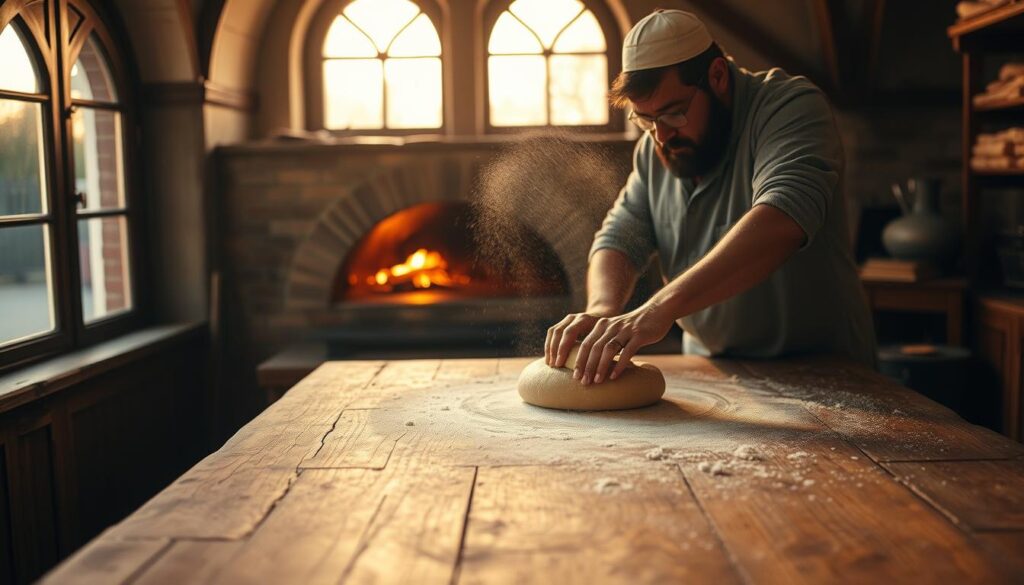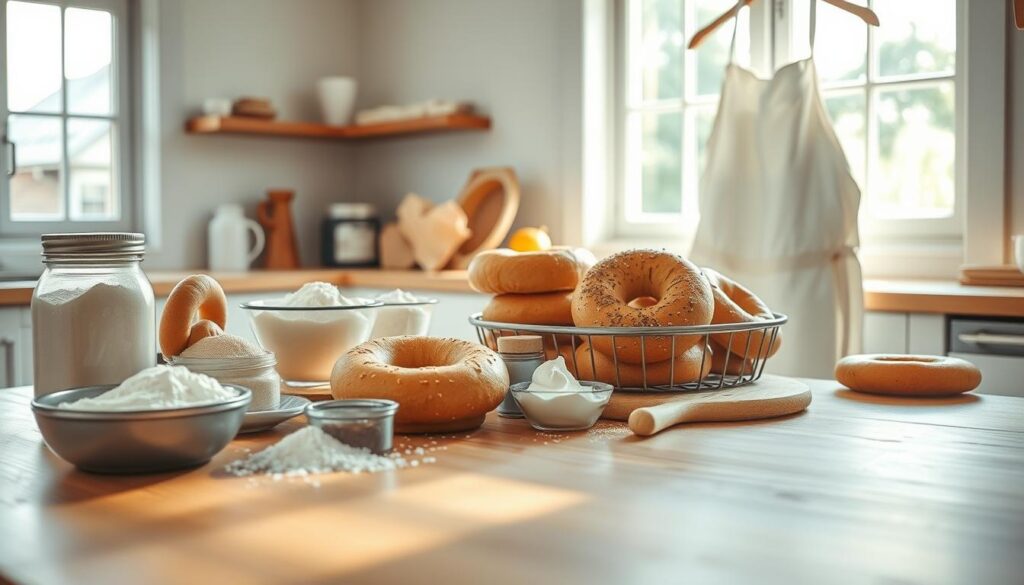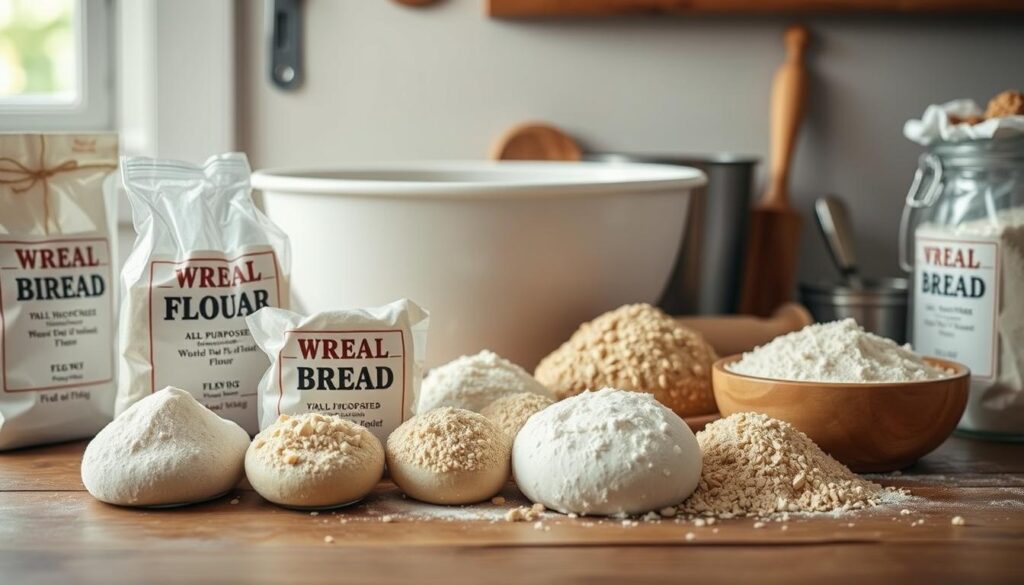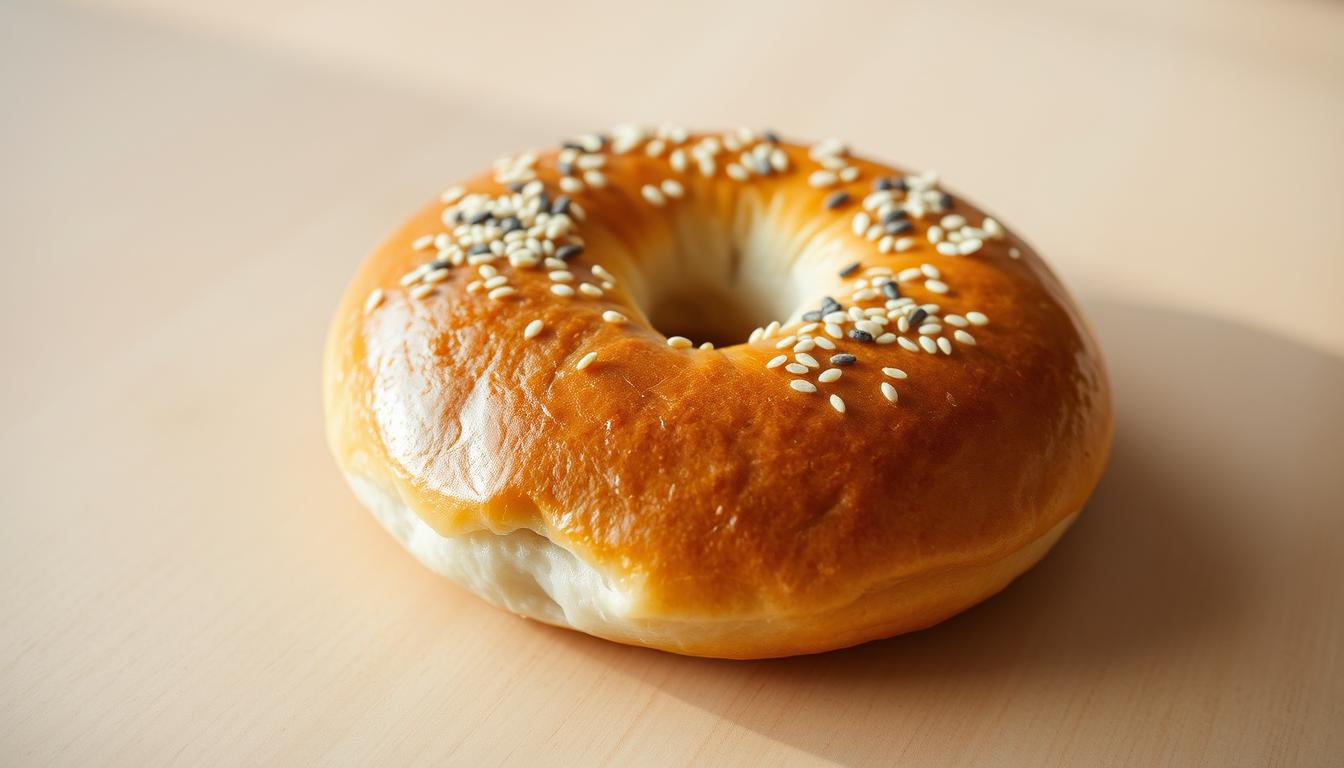Growing up in a bustling New York kitchen, bagels were more than just bread. They were a cherished family tradition. My grandmother’s hands would skillfully knead dough, transforming simple ingredients into golden, chewy rings.
Creating the perfect bagel recipe isn’t about complicated techniques. It’s about understanding four simple fixes. These fixes can elevate your homemade bagels from ordinary to extraordinary. Whether you’re a baking novice or a seasoned home cook, this easy bagel recipe will help you craft bakery-quality bagels right in your own kitchen.
Imagine pulling out a tray of freshly baked bagels. Their exterior is crisp and glossy, their interior soft and pillowy. With these four transformative techniques, you’ll unlock the secrets to making bagels that rival those from the most prestigious New York delis. Get ready to embark on a delicious journey that will change how you think about homemade bread forever.
Let’s dive into the world of bagel making. Discover how four simple fixes can turn your kitchen into a bagel lover’s paradise.
Table of Contents
Understanding the Magic Behind Perfect Bagels

Bagel-making is an art form with deep roots in culinary tradition. Your journey to making the perfect traditional bagel recipe starts with understanding its rich history and scientific details.
The History of Traditional Bagels
The jewish bagel recipe began in the Jewish communities of Poland in the 16th century. These circular bread rings quickly became a staple in Eastern European cuisine. Bakers made bagels as a portable, durable food that could be easily carried and shared.
“A bagel is a piece of Jewish history you can taste” – Unknown Baker
- Originated in Polish Jewish communities
- Traditionally hand-rolled and boiled
- Symbolized community and connection
Why Texture Matters in Bagel Making
Texture is key to a great bagel. The chewy outside and soft inside make authentic bagels stand out from regular bread. Your technique is what makes your traditional bagel recipe memorable or not.
The Science of Bagel Chemistry
Creating a bagel involves complex chemical reactions. Gluten, protein, and precise boiling techniques turn simple ingredients into a culinary masterpiece. Knowing these scientific principles can take your jewish bagel recipe from good to amazing.
- Gluten creates structural integrity
- Boiling develops distinctive crust
- Protein content impacts texture
Mastering bagel-making requires patience, practice, and a deep appreciation for culinary science.
Essential Ingredients for Foolproof Bagels

Starting a perfect bagel recipe means knowing the key ingredients. These ingredients turn simple dough into a tasty breakfast treat. Many home bakers use all-purpose flour, but pros know the right mix makes a big difference.
Your bagel’s success depends on choosing top-notch ingredients. They must work well together. Here are the must-haves:
- Flour: High-protein bread flour or high-gluten flour gives the chewy texture
- Active dry yeast for rising and texture
- Kosher salt for extra flavor
- Warm water to start yeast
When picking flour, think about protein content. All-purpose flour works, but bread flour with more protein is better. It makes the bagel chewy and dense, just like the ones you love.
Pro tip: Weighing your ingredients ensures consistent results every time you bake!
Adding barley malt syrup or honey can deepen your bagel’s flavor. These sweeteners boost taste and make the crust golden and appealing.
- Barley malt syrup
- Honey
- Sugar (in small amounts)
By picking each ingredient carefully, you’re on your way to baking amazing bagels at home.
The First Fix: Proper Flour Selection

Creating the perfect bagel recipe starts with choosing the right flour. Your flour selection can make or break your homemade bagels, turning them from ordinary to extraordinary.
When crafting your bagel recipe, understanding flour types is crucial. Not all flours are created equal. The protein content plays a significant role in achieving that classic bagel texture.
Why Bread Flour Reigns Supreme
Bread flour stands out in the bagel recipe world for several key reasons:
- Higher protein content (12-14%)
- Better gluten development
- Creates a chewier, more authentic bagel texture
Protein Content and Gluten Magic
Your bagel recipe all-purpose flour might work in a pinch, but it lacks the protein punch needed for truly exceptional bagels. Bread flour’s higher protein content means:
- Stronger gluten networks
- More elastic dough
- Better structure and chew
Measuring for Bagel Perfection
Precision matters when measuring flour for your bagel recipe. Invest in a kitchen scale to ensure consistent results every time. Scoop and level method can compress flour, leading to dense, heavy bagels.
Pro tip: Always weigh your flour for the most accurate bagel recipe measurements!
By selecting the right flour and measuring carefully, you’re one step closer to creating bakery-worthy bagels right in your own kitchen.
Your Ultimate Bagel Recipe Guide
Ready to make the perfect bagel at home? This easy recipe will turn your kitchen into a bakery. Making bagels from scratch might seem hard, but with the right steps, you’ll make delicious homemade bagels quickly.
Let’s look at the key ingredients for your bagel recipe:
- 4 cups bread flour
- 2 teaspoons active dry yeast
- 1½ teaspoons salt
- 1½ cups warm water
- 1 tablespoon honey or malt syrup
The secret to a great bagel recipe is knowing each ingredient’s role. Bread flour makes the bagels chewy and authentic. Active dry yeast makes them rise. Salt adds flavor and controls fermentation.
Your bagel-making journey includes several important steps:
- Mix dry ingredients
- Knead dough until smooth
- Let dough rise
- Shape bagels
- Proof and prepare water bath
- Boil briefly
- Bake until golden
Pro tip: Spend time kneading and shaping for professional-looking bagels!
Homemade bagels aren’t just food—they’re a delicious art form you’ll master with practice.
The Second Fix: Mastering the Water Bath
To make a real New York bagel, you need to get the water bath right. This step turns simple dough into a chewy, shiny bagel that’s a true classic.
The water bath is key to getting that perfect bagel texture. Before baking, each bagel gets a quick soak in hot water. It might seem strange, but it works magic in your kitchen.
Optimal Water Temperature Matters
Your water should be between 180-200°F. This temperature is just right for the outside and gets the dough ready for baking:
- Too cool: Bagels won’t develop a crisp crust
- Too hot: Dough can become mushy
- Just right: Creates a beautiful golden-brown exterior
Timing Your Boil
Boiling time is very important. You want to boil each bagel for 30-60 seconds on each side. This short time helps set the crust and makes the bagel chewy.
Enhancing Flavor with Sweeteners
Pro bakers add honey or barley malt syrup to the water. These natural sweeteners help with browning and add a rich flavor. They make your New York bagel recipe truly special.
Shaping Techniques for Professional-Looking Bagels
Making the perfect bagel is more than just the ingredients. It’s about the art of shaping. Mastering two main shaping methods is key to bringing your bagel recipe ideas to life.
The rope method is a timeless technique for creating stunning bagels. Begin by dividing your dough into equal parts. Roll each into a ball, then shape it into a 10-inch rope. Wrap the rope around your hand, joining the ends to form a circular shape with no seams.
- Keep your hands lightly floured to prevent sticking
- Ensure even thickness throughout the rope
- Pinch the ends together firmly to seal
The punch method is great for bagels with a rustic look. Start with a tight dough ball. Use your thumb to punch a hole in the center. Stretch the hole to 2 inches wide, rotating the dough to keep it even.
Pro tip: Practice makes perfect! Don’t get discouraged if your first few bagels look imperfect.
Whether you use the rope or punch method, consistency is crucial. Take your time to ensure your shapes are even. Your effort will pay off with bagels that look like they were made by a pro.
The Third Fix: Perfect Proofing Method
Mastering the proofing process is key to making great sourdough bagels. Proofing isn’t just waiting—it’s where magic happens. It develops deep flavors and creates the perfect texture.
Your sourdough bagel recipe’s success depends on understanding proofing. This process lets yeast work its magic. It creates complex flavors and the ideal rise.
Temperature Control Secrets
Achieving the right proofing environment requires careful attention to temperature. The ideal proofing space should be:
- Warm (around 75-80°F)
- Humid (prevents dough from drying out)
- Draft-free
Visual Indicators of Ready Dough
Knowing when your sourdough bagel dough is perfectly proofed comes down to these key visual cues:
- Gentle Indentation Test: Press the dough lightly. It should slowly spring back
- Visible air bubbles on surface
- Dough looks slightly puffy and increased in volume
Professional bakers know that patience during proofing can make or break your sourdough bagel recipe. Listen to your dough—it will tell you exactly when it’s ready to be shaped and baked.
Essential Equipment for Bagel Making
Making perfect bagels at home is easy with the right tools. You don’t need a fancy kitchen to make delicious homemade bagels. The right equipment makes the process simpler and more consistent.
Here are the essential tools for making tasty homemade bagels:
- Large Mixing Bowl: A big bowl is key for mixing and kneading the dough
- Heavy-Bottomed Pot: It’s vital for boiling the bagels before baking
- Baking Sheet: It helps shape the bagels evenly
- Wire Cooling Rack: It ensures bagels cool without getting soggy
There are also some optional tools that can make your bagel-making better:
- Kitchen Scale: It helps measure ingredients accurately
- Stand Mixer: It makes mixing the dough easier
- Silicone Baking Mat: It prevents sticking and bakes evenly
Pro tip: Invest in quality tools that will last through many bagel-making adventures!
You don’t need fancy bakery equipment to make amazing bagels at home. Quality tools and your love for baking are all you need.
The Fourth Fix: Baking Temperature and Timing
Getting your bagel recipe right means paying close attention to baking temperature and timing. With the right steps, your homemade bagels will turn from simple dough into golden-brown treats. Professional bakers say the key is controlling the temperature for that perfect crispy outside and soft inside.
Set your oven to 425°F (218°C) for a hot bake. This high heat creates the bagel’s signature crust and cooks the inside just right. Make sure to preheat your oven for at least 30 minutes to get it to the perfect temperature.
- Preheat oven to 425°F
- Use a baking stone for even heat distribution
- Bake for 20-25 minutes
- Watch for golden-brown coloration
Success with your bagel recipe comes from knowing when to stop baking. Look for a deep golden-brown color that means your bagel is done. The surface should be shiny and slightly crunchy, with the same color all over.
Pro tip: Rotate your baking sheet halfway through cooking to ensure even baking and prevent potential hot spots in your oven.
Bagel size can affect baking time. Smaller ones might need 18-20 minutes, while bigger ones could take 25 minutes. Always keep an eye on your bagels to avoid overcooking.
Creative Topping Ideas and Combinations
Make your bagel recipe ideas exciting with new toppings. These can turn a simple breakfast into a fun adventure. Whether you like classic flavors or want to try something new, the right topping can make your bagel special.
Your bagel is ready for a tasty makeover. Let’s explore some delicious toppings that will inspire you and make your mouth water.
Traditional Jewish Toppings
Classic bagel recipes often use traditional Jewish baking methods. These toppings add real flavor and texture to your homemade bagels:
- Sesame seeds: A nutty, golden coating
- Poppy seeds: Delicate and slightly peppery
- Dried onion flakes: Savory and aromatic
- Coarse sea salt: Adding a perfect crunch
Modern Flavor Innovations
Try new topping combinations to take your bagel recipe ideas to the next level:
- Everything Bagel Seasoning: A mix of garlic, onion, poppy seeds, and salt
- Everything Spice mix: Adds complexity and depth
- Herb-infused toppings like za’atar or dried rosemary
- Sweet options like cinnamon sugar or maple crumble
Pro tip: Brush your bagels with an egg wash before adding toppings. This helps them stick well during baking. Your homemade bagels will look and taste like they were made by a pro!
Storage Tips and Reheating Methods
After perfecting your bagel recipe, knowing how to store and reheat your delicious homemade bagels is crucial. Fresh bagels are amazing right out of the oven. You’ll want to keep that incredible taste and texture for days to come.
For short-term storage, your freshly baked bagels can sit at room temperature for 2-3 days. To keep them fresh, follow these tips:
- Allow bagels to cool completely before storing
- Use an airtight container or sealed plastic bag
- Keep at room temperature away from direct sunlight
- Avoid storing in refrigerator, which can dry out bagels
For long-term preservation, freezing is your best option. Your bagel recipe can be stored frozen for up to 6 months with proper technique:
- Slice bagels before freezing
- Wrap individually in plastic wrap
- Place wrapped bagels in freezer-safe bag
- Remove air to prevent freezer burn
Reheating requires gentle care to restore that fresh-baked texture. Pro tip: Avoid microwaving, which can make bagels tough. Instead, use these methods:
- Toaster oven: 350°F for 3-5 minutes
- Regular oven: Wrap in foil, heat at 375°F for 5 minutes
- Toaster: Use medium-low setting to prevent burning
With these storage and reheating tips, your homemade bagel recipe will taste incredible every single time.
Conclusion
Making the perfect bagel is an art that mixes science, skill, and love. With the four simple fixes we’ve shared, you can turn your kitchen into a pro bakery. Your bagel-making skills will grow with each batch, turning kitchen mistakes into tasty breakfast wins.
Every top baker began where you are today. The secret to amazing bagel recipes is practice, patience, and a spirit to try new things. Feel free to tweak ingredients, experiment with toppings, or change techniques until you find your unique style. Baking bagels is about loving the journey as much as the delicious outcome.
Your homemade bagels will quickly become a hit with your family and friends. They’ll be impressed by the quality of your homemade bread, beating anything from the store. With each batch, you’ll get better at baking. Enjoy the process, learn from each try, and relish the warm, fresh bagels from your oven.
Begin baking, stay curious, and most importantly, have fun making your perfect bagels!

